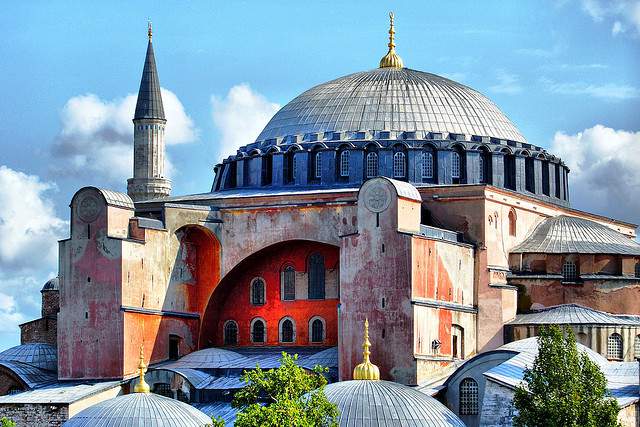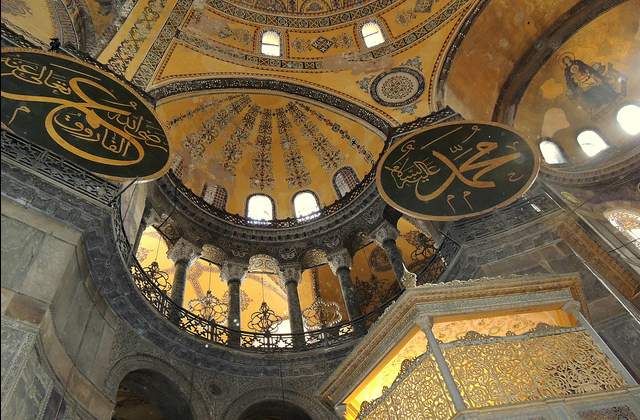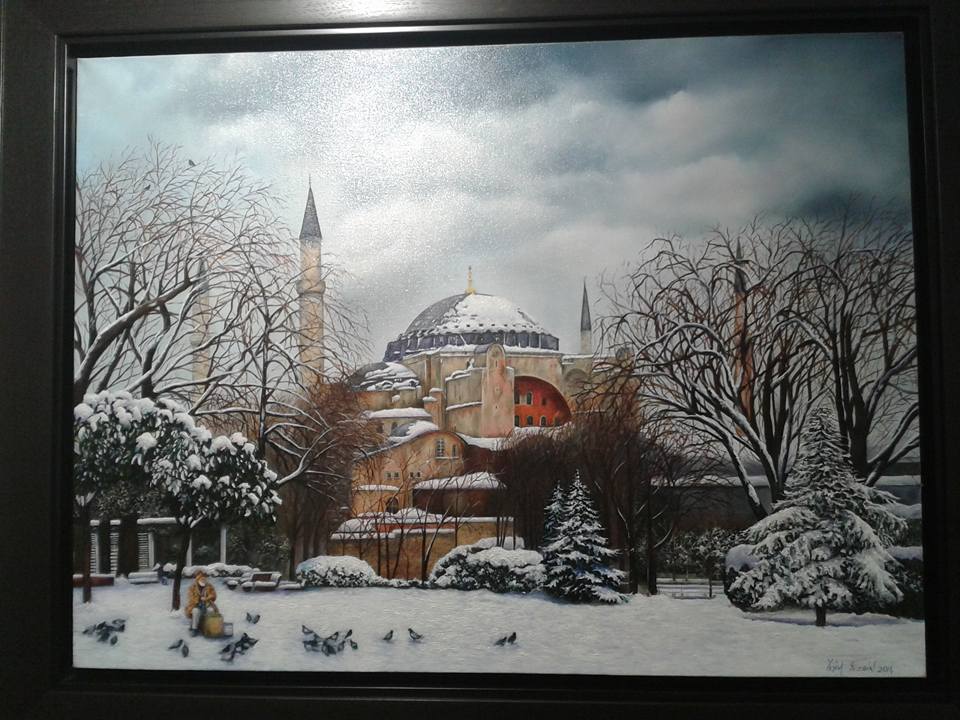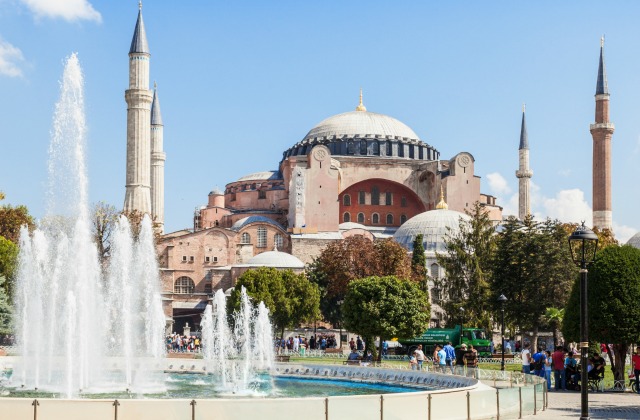[Home] › [Attractions] › [Hagia Sophia]
hagia sophia in istanbul (ayasofya)
History & Visiting tips
Hagia Sophia is Istanbul’s most outstanding monument. It was a church in Byzantine times, a Roman Catholic cathedral under Latin Empire, a mosque in Ottoman times, a museum when Turkey became a republic and a mosque again starting July 2020. Definition of Hagia Sophia translates as "Divine Wisdom".
Hagia Sophia has seen three reconstructions made in three different architectural styles. Hundreds of architects and their apprentices worked on this masterpiece over its lifetime of over 1500 years.
Hagia Sophia in Istanbul plays an important role in the world of art and architecture.
 Photo by David Spender
Photo by David SpenderLocation: Ayasofya Square (Meydani), Sultanahmet, Fatih, Istanbul. Take a tram to Sultanahmet stop.
Church of Hagia Sophia
"Solomon I have outdone thee"
First version of the church of Hagia Sophia was built in the year 360. It was nicknamed “the Great Church” because of the grandiose size in comparison to other local churches in the area. This first church at that time was also recognized as one of the most impressive in the world. This was a wooden structure built in traditional Latin style. The Great Church was a basilica with columns and galleries characteristic to those times. The construction easily burnt down during public riots 44 years later. No remains of the first church survived to our days.
Second time the church was constructed in 415 and also had a wooden roof. This second church also suffered greatly during riots, the Nika riots, in 532.
Third construction of the church became the Hagia Sophia, major part of which you can see now. It was built in 537 in exactly the same location as previous two churches. Byzantine Emperor Justinian I ordered the construction. It took 5 years to build the church and make it open to worshipers.
Greek mathematician and architect Anthemius of Tralles made a daring design for the new church and rebuilt what is now the Hagia Sophia. However he died one year into the construction. Isidore of Miletus was another scientist and mathematician who was commissioned by Justinian I to co-design the church. He continued with the project till the end.
When Hagia Sophia in Istanbul was completed and Emperor Justinian I saw the temple for the first time, he exclaimed “Solomon I have outdone thee.” Justinian referred to Solomon’s Temple (known as the First Temple in Jerusalem) described in the Bible.
Hagia Sophia became the main church of Eastern Christianity. Emperors were crowned here. It served the followers of Christianity for 9 centuries.
Architecture and design
 Photo by Anita Gould
Photo by Anita GouldConstruction of Hagia Sophia began In 532. The design combined ideas of previously built churches, the two basilicas. Central dome became the main difference of the new construction. The dome was so big and grandiose its weight has been a problem through the entire existence of Hagia Sophia. Several earthquakes damaged the structure severely. Because of many repairments the dome underwent, it lost its original shape. The dome’s diameter now varies from about 30 to 31 meters (about 101-102 ft) depending on places of measurement.
A total of 104 columns support domes and make up the design of Hagia Sophia. The columns came from ancient Greek and Egypt.
Several types of marble was used for the construction of Hagia Sophia - white, green, pink, yellow. Stones came from what now is Turkey, Greece and North Africa. All territories of Roman Empire under Justinian I were required to provide the best material and workforce for the construction of Hagia Sophia. It was the largest and most important construction of that time.
Interior of Hagia Sophia was filled with exclusive mosaics and marble. Images of figures, plants and geometrical shapes were depicted on the walls. Dome had a painting of Jesus Christ and Virgin Mary. Part of the paintings remained to our days at the upper gallery.
Hagia Sophia as a church served for 916 years.
Hagia Sophia in Istanbul - the mosque
 Painting by Yesim Sezgin
Painting by Yesim SezginIn 1453 a 21-year old Ottoman Sultan Mehmed II, known as Mehmed the Conqueror, took Constantinople. He entered the city from what later became the Topkapi Palace and ordered Hagia Sophia in Istanbul to be converted into a mosque.
One of the Sultan’s religious scholars climbed the highest point of Hagia Sophia and uttered Muslim statement of faith (Shahada in Turkish). “There is no god but God. Muhammad is the messenger of God”.
Hagia Sophia became the first imperial mosque in Istanbul. Later the Blue Mosque (Sultan Ahmed Mosque) was built and claimed the imperial status.
Hagia Sophia in Istanbul today has four minarets. Not all four minarets were introduced to the building at the same time. Two of the towers were commissioned by Ottoman Sultan Bayezid II (1447-1512), the other two by Sultan Selim II (1524-1574).
Hagia Sophia served as a mosque for 482 years.
In 1935 when Turkey became a Republic, its first president Mustafa Kemal Ataturk converted the Hagia Sophia mosque in Istanbul into a museum.
Hagia Sophia facts
 Hagia Sophia museum
Hagia Sophia museum- Definition of Hagia Sophia comes from Greek language. Hagia Sophia means Holy Wisdom or Divine Wisdom.
- Hagia Sophia as a church was built as a dedication to Jesus Christ.
- Columns used in Hagia Sophia came from all over Anatolia and adjacent regions at the order of Justinian I.
- Wish column (in the northwest of Hagia Sophia) is believed to have super powers. It becomes damp when touched and has a second nickname “the crying column”. Touch the bronze round part of the column to get a cure from any illness or have your wish come true.
- Justinian I did not live long enough to see the completion of the mosaics inside the Hagia Sophia. Justinian II commissioned the completion of mosaic work.
- To decrease the weight of the heavy dome 40 windows were incorporated in its design. The windows not only brought the light into the holy place of worship but also made the dome lighter.
- Constantinople was captured on May 29. Ottoman Sultan Mehmed II prayed in the Hagia Sophia the mosque on June 1, two days after the capture of Catholic city.
- Mimar Sinan, famous Ottoman architect, first earthquake engineer in the world, re-designed, re-built the Hagia Sophia mosque through its existence.
- Even though Hagia Sophia in Istanbul is now a museum, starting from 2013 you can hear muezzin (a muslim person appointed to call to prayer) singing the prayer from the minarets twice per day.
- (!) Little Hagia Sophia is a separate stand alone construction with one minaret located south of Hippodrome. See video of Little Hagia Sophia.
